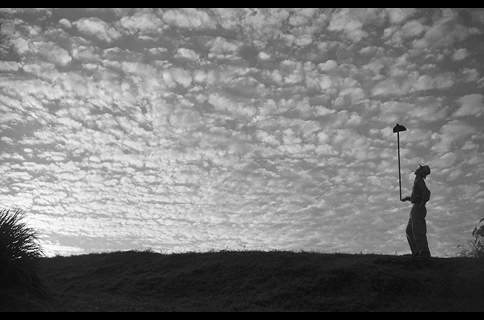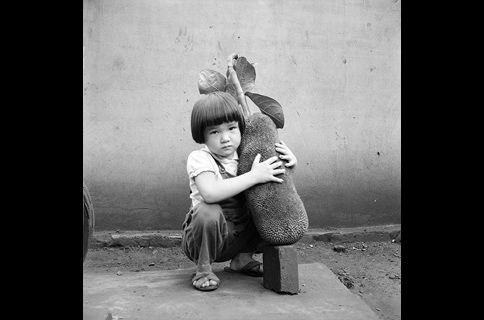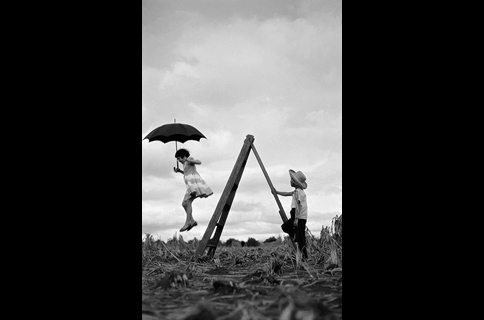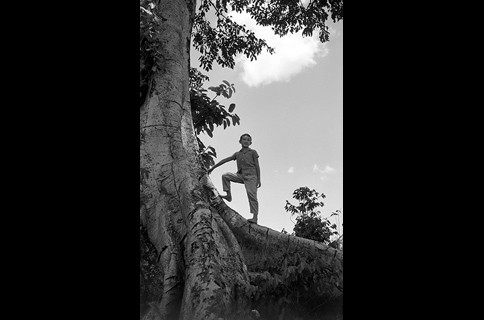- Home
- Exhibitions & Events
- Living on Brazil's Wide Earth — The Hidden Story of Emigrant Photographer Ohara Haruo
Photo History Museum FUJIFILM SQUARE
Living on Brazil's Wide Earth —
The Hidden Story of Emigrant Photographer Ohara Haruo
The Photo History Museum at FUJIFILM SQUARE is pleased to announce the photo exhibition “Living on Brazil's Wide Earth — The Hidden Story of Emigrant Photographer Ohara Haruo” which runs from October 1 — December 28, 2017.
Thankful for the seed cast yesterday;It is what made today's flower bloom
Ohara Haruo
There was a Japanese man who emigrated to Brazil as pioneer farmer, mastered photographic technology on his own and received high praise from critics at home and abroad through for creating his own world of photography. His name is Ohara Haruo. In 2016, beginning with his home prefecture Kochi, a big exhibition travelled throughout Japan, which drew enthusiastic response from the public. This exhibition presents 22 selected works from this travelling exhibition, giving also the people in the greater Kanto area a chance to get a look at Ohara Haruo's marvelous works.
In 1927, at the age of seventeen, Ohara and his family emigrated to Brazil as part of a larger group of Japanese immigrants. After arriving in Brazil he first had to work as farm laborer under slave like conditions in São Paulo. In order to live a more autonomous and unrestricted life, the family later moved to the undeveloped areas of Londrina in the state of Paraná as one of the first to settle there and where they would live s farmers for a long time.
At the age of 24 he married. It was his wedding that made him think about ways to record important events in his life and finally led him to buy his first camera a few years later. It does not surprise, thus, that his first photograph depicts his wife Kou. From then on Ohara continued to make photographs when he had time to spare from work at his farm. He studied and mastered photographic technique on his own, gradually spending more and more time with his camera. A subject that Ohara continuously depicted were the all-encompassing landscapes, the nature of Londrina; Landscapes structured by a sky and a horizon that Ohara himself opened up by developing the primeval forests of Londrina. Against the background of this wide sky we also find Ohara himself. This is a figure full of joy over having overcome previous hardships. Yet, it is not him but the vast land of Londrina that most of the time takes the center stage. His photographs bespeak of a deep connection between nature and human — one that might seem distant and yet at the same time familiar for us today.
From the early 1970s on, Ohara, after becoming a member of the local photo club, began to attract attention from local newspapers and subsequently became known to a broader public. In 1998, he held his first solo-exhibition which created considerable reaction from critics and visitors alike. He thought about returning to Japan shortly before his death. However, in August 1999 he died in Londrina at the age of 89, surrounded by his family. In 2008, commemorating the centenary of Japanese immigration to Brazil, his family donated his photographs and documents to the Instituto Moreira Salles, Brazil's leading archive of photographic material.
He himself didn't return to Japan. Ohara's works however finally found their way here. Thanks to the full support by the Instituto Moreira Salles, this exhibition will show 22 carefully selected and representative works of this great artist.
Artist Information
Born on November 5, 1909 as the eldest son to farmers in Misemura (present-day town of Ino) in the district of Agagawa, located in the Kochi prefecture on the south coast of Shikoku. In 1927, at the age of seventeen, he and his family emigrate to Brazil. After working as farm laborer in São Paulo he moves to Londrina in the state of Paraná in 1933, as one of the first to settle there. Ohara acquires his first camera at the age of 29 and starts taking photographs in the spare time between growing fruits and coffee at his farm. In 1951 he moves to the urban area of Londrina due to an airport being built next to his home. There he becomes a member of the Photo Cinema Club Bandeirante, a photographic association founded in 1939. In the latter half of the 1960s he begins to participate in photographic salons in Brazil and abroad while working at his farm. First an unknown amateur photographer, from the 1970s on his photographs start to attract attention from local newspapers. In 1998, he holds his first solo-exhibition Olhares (‘Looks') at the 2nd International Biennial of Photography in Curitiba and the International Festival Londrina. He dies in Londrina in August 1999 at the age of 89, surrounded by his family. In 2008, commemorating the centenary of Japanese immigration to Brazil, his family donated his photographs and documents to the Instituto Moreira Salles. In 2015, the year of the 120th anniversary of the establishment of diplomatic relationships between Brazil and Japan, he was introduced to a broader Japanese public through various NHK documentary programs such as ‘Japanese breaking new ground — 120 years Brazil-Japan', ‘Crossing Boarders — 120 Years of Friendship between Brazil and Japan' and ‘The Sunday Museum: Ohara Haruo, Emigrant Photographer of Brazil's wide hinterland'.
| Title | Living on Brazil's Wide Earth — The Hidden Story of Emigrant Photographer Ohara Haruo |
|---|---|
| Period | October 1, 2017 — December 28, 2017 Open every day from 10:00-19:00 (last admission 18:50) |
| Number of works | 22 |
| Venue | The Photo History Museum at FUJIFILM SQUARE |
| Admissions | Free |
| Organization | FUJIFILM Corporation |
| Cooperation | The Embassy of Brazil, Instituto Moreira Salles |
| Collaboration | The Minato-ku Board of Education |
| Planning and Production | Contact Co., Ltd. |
Events during the exhibtion
1. Gallery Talk by Hirama Itaru (photographer; appeared on the NHK Educational Program ‘The Sunday Museum: Ohara Haruo, Emigrant Photographer of the wide Brazil's wide hinterland')
| Date | November 4, 2017, 14:00-14:30, 16:00-16:30 |
|---|---|
| Venue | The Photo History Museum at FUJIFILM SQUARE |
| Admissions | Free * No registration required * No seats available |
2. Gallery Talk by Sakai Kunihiro (Director of the NHK documentary ‘The Sunday Museum: Ohara Haruo, Emigrant Photographer of the wide Brazil's wide hinterland')
| Date | December 2, 2017, 14:00-14:30, 16:00-16:30 |
|---|---|
| Venue | The Photo History Museum at FUJIFILM SQUARE |
| Admissions | Free * No registration required * No seats available |
In 2017, the Photo History Museum was formally approved by the Association for Corporate Support of the Arts for its “contributions to society through the promotion of arts and culture” and was permitted to use the official “This is MECENAT 2017” mark.





